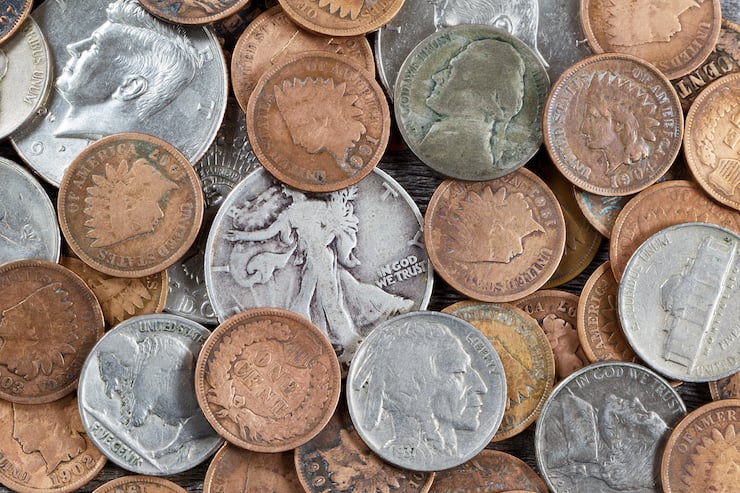When he was president, Theodore Roosevelt, a patron of arts and letters, commissioned the redesign of American coins, especially the small denominations in common circulation, from the penny to the dollar.
He was right to complain about the existing designs; at least about the nickel, the dime, the quarter, and the half. However, the Indian penny is, to my eye, easily the most beautiful of our cents: Miss Liberty on the obverse is an Indian princess, with a feather headdress and a coronet reading LIBERTY. The silver dollar designed by George T. Morgan—hence its popular name, the Morgan Dollar—is also striking, with the grand eagle on the reverse, wings outspread, clutching in its talons both the arrows of war and the olive branch of peace.
But the dime, the quarter, and the half all had the same pleasantly classical but unexceptional bust of Liberty on the obverse, and the nickel was pallid, too, its reverse dominated by a large Roman numeral V, for five cents. The word “cents” had to be added in 1883, the first year of the coin’s issue, because unscrupulous men in the hinterlands would plate the nickel with gold and pass it off for five dollars. I have one such, hardly touched by wear.
It is hard for us to imagine that ordinary people used to care about the design of public objects: coins, dollars, bridges, court houses, town halls, churches, schools, and even factories. We are the people, to extend C. S. Lewis’s wry observation, for whom not only is drab a favorite color, but box is a favorite shape, prose is a favorite meter, grunt is a favorite melody, and nose is a favorite place for a ring. But so it was, and Roosevelt’s call for a refurbishment of the coinage met with approval. The best-known engravers and sculptors submitted designs, and the results were splendid.
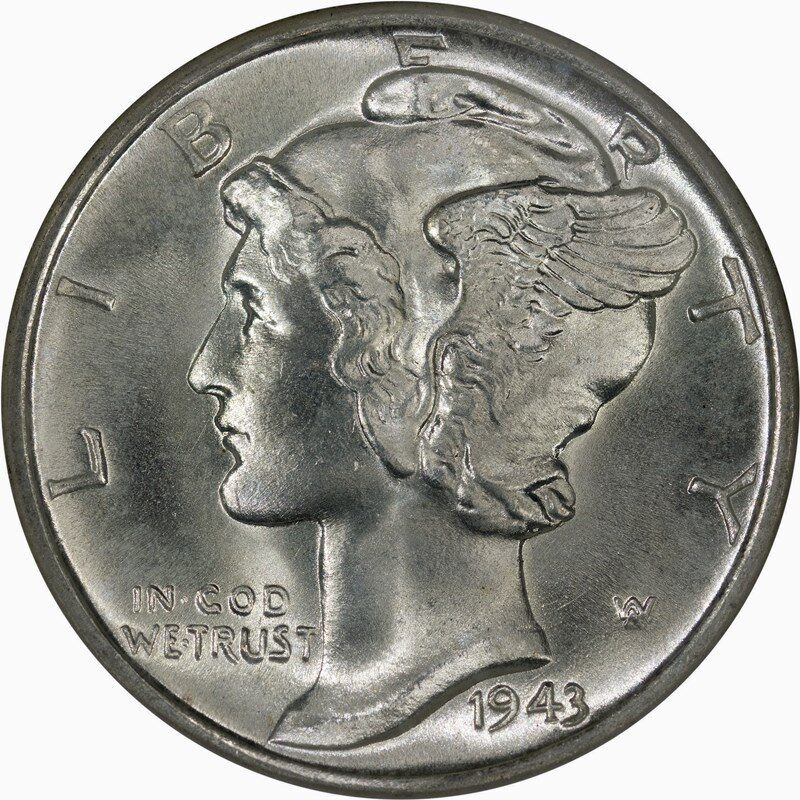 Some of these designs warrant a closer look for what they suggest about their time—and ours. Take the Winged Liberty dime, for example. This coin was quickly tabbed as the “Mercury dime,” and so it is still known by most people, including collectors who know better. The engraver Adolph Weinman used as a model for Miss Liberty a tenant of his, a young lady named Elsie Stevens, whose husband was a lawyer and insurance man named Wallace Stevens; a Republican and conservative, later to win fame as a poet of marked originality and power.
Some of these designs warrant a closer look for what they suggest about their time—and ours. Take the Winged Liberty dime, for example. This coin was quickly tabbed as the “Mercury dime,” and so it is still known by most people, including collectors who know better. The engraver Adolph Weinman used as a model for Miss Liberty a tenant of his, a young lady named Elsie Stevens, whose husband was a lawyer and insurance man named Wallace Stevens; a Republican and conservative, later to win fame as a poet of marked originality and power.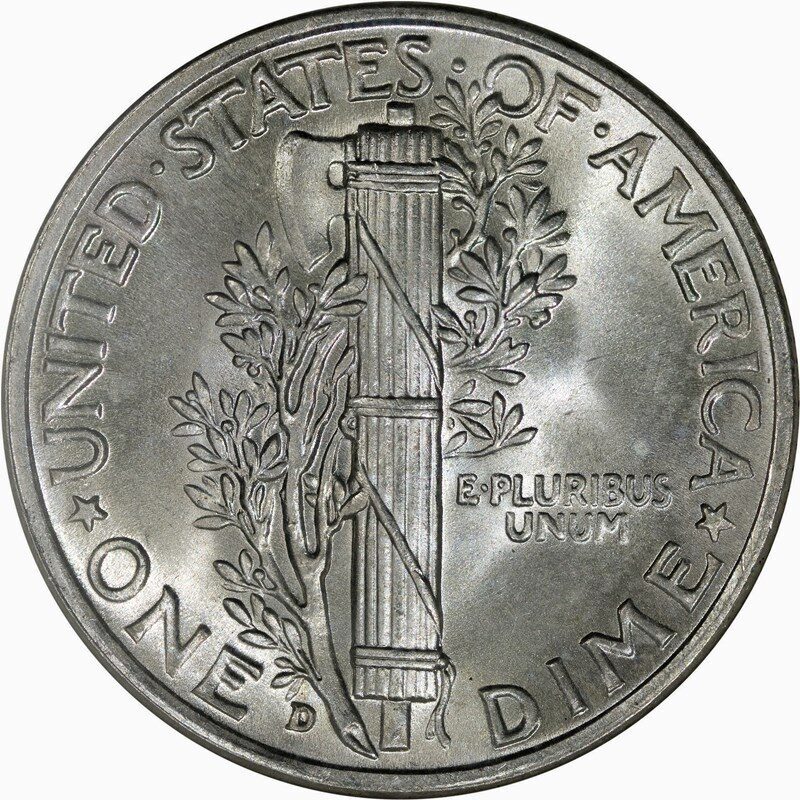
Winged Liberty wears a Phrygian cap, a classical symbol of freedom that had been employed on American coinage in the past. Weinman decided to embellish that cap with wings. His friend and teacher, Augustus Saint-Gaudens—himself the designer of what many critics praise as the single most beautiful American coin, the double eagle with Liberty striding forth—had shown Weinman how to engrave feathers in relief.
His inspiration came not from the ancient messenger-god, thief, and usher for the dead, swift footed Hermes. It came from Miss Liberty herself. Weinman said he wanted to craft an allegory for freedom of thought. The coin was issued in 1916, amidst war in Europe, two years before the emergence of a great plague, and one year before a great ideology of vengeance, envy, hatred, materialism, irreligion, and totalitarian control descended upon the continent, via the Bolshevik Revolution in Russia.
The reverse of the coin is handsome too and is meant to balance or to give context to the obverse. It shows the fasces, the bundle of rods, with its traditional ax, carried by the Roman lictor as symbols of national unity and state force. This is the same ancient symbol that Mussolini would soon adopt for the name of his law-and-order movement in Italy: Fascism. The fasces were not new to American symbolism, which borrows heavily from Ancient Rome. The fasces are to be found everywhere: see, for a rather unsettling example, the vertical sides of the throne upon which Abraham Lincoln sits in his memorial.
Of course, Weinman and the U.S. Mint officials who selected his design cannot be held responsible for what an Italian despot would do with this symbol clear across the ocean, but I do not know that anyone was uncomfortable with it even then, nor do I see why anyone should have been. The idea behind the fasces is the same as what animated Benjamin Franklin when he said that he and his fellow seekers of independence had better hang together, or they would all hang separately. You can easily snap rods over your knee one by one, but not if you bind them all together.
It bears mentioning not only how Miss Liberty is portrayed, but that she is portrayed at all. George Washington may have been first in peace, first in war, and first in the hearts of his countrymen, but he was not first on our coins. Emperors and kings stamp gold with their faces, but we Americans were supposed to not hold generals and politicians in that sort of quasi-divine regard.
And we didn’t—at least not at first. No historical personage appears on American coins until 1909, when the bust of Lincoln graced the penny, where he remains to this day. Once Lincoln broke the tradition, he was followed by Washington (quarter, 1932), Jefferson (nickel, 1938), Roosevelt (dime, 1946), Franklin (half, 1948), Kennedy (half, 1964), Eisenhower (dollar, 1971), Susan B. Anthony (dollar, 1980), and Sacagawea (dollar, 2000).
Most of those designs we could do without, especially after such long duration. The likeness of Roosevelt is poor, unless it was meant to portray him as a mild-mannered glad-hander. Why we should celebrate Kennedy, I do not know. The Susan B. Anthony dollar is a study in what not to do with coins. Rep. Patricia Schroeder (D-Colo.) had been insisting that it was high time for a woman to appear on our money, and, presumably after exhumation and a forensic inquest, it was determined that Miss Anthony met the requirement. She was placed on the obverse, but since the moon landing had been on the reverse of the Eisenhower dollar, it remained on hers too, giving us barrenness on both sides. The public disliked the coin, because it was too easy to confuse with the quarter—and besides, it was ugly.
If historical figures are to decorate our money with their mugs, could we not at least choose somebody besides politicians, or a single-minded scold, or the common-law wife of a French Canadian trapper, whose importance to the Lewis and Clark expedition is undeniable, but who is therefore subordinate in importance to many an explorer, including Lewis and Clark themselves?
The Italians, before the advent of the ghastly euro and the Bauhaus design of its coins, had on their colorful bank notes heroes of their culture: the educational reformer Maria Montessori, the scientists Guglielmo Marconi and Alessandro Volta, the composer Bellini, and the artists Titian, Caravaggio, and Bernini. In the U.S. we might dream of someday seeing Herman Melville on a gold coin, for some patriotic citizen to nail it to a post in the Capitol, promising it and a million like it to any man who could harpoon just one of the thousands of white whales snorting and sporting in the ocean of our modern managerial state.
It occurs to me that we have inverted the Winged Liberty dime. Freedom of thought requires two things, to wit, freedom and thought. You cannot have freedom without virtue, said every Christian theologian as well as every pagan philosopher and statesman who ever lived. But we insist upon freedom from virtue, from manliness; and so we end up with compulsions, surveillance, and confinement. Ask anyone who dares to express a disapproved thought at Gomorrah State University.
You cannot have genuine thought unless you are in contact with reality: either the excellent world about us with all its salutary resistance to our wills, or the world as the great artists, poets, and thinkers from the past can present it to us. Freedom of thought thus requires discipline, strength, and honest submission to truth. Otherwise we are talking about license and fantasy, slack and effeminate; these come to us readily from the manipulations of mass education and mass advertising. Think of the drag queens grooming the minds of little children at your local library.
Meanwhile, since license is chaotic and fantasy unstable and unpersuasive, we find ourselves more and more under suspicion, lest any man utter the truth or act upon it.
We need new coins to reflect our modern reality. I propose a new Charon dime. It should feature on the obverse the head of a boy, listless, drooping, eyes half shut, an emblem of resigned captivity. On the reverse, a heap of scattered rods, I Ching wands perhaps, forming the 47th hexagram, the Swamp, an allegory of confinement and oppression. And a new legend engraved: TRUST PUBLIC SCHOOLS AND THE FBI.
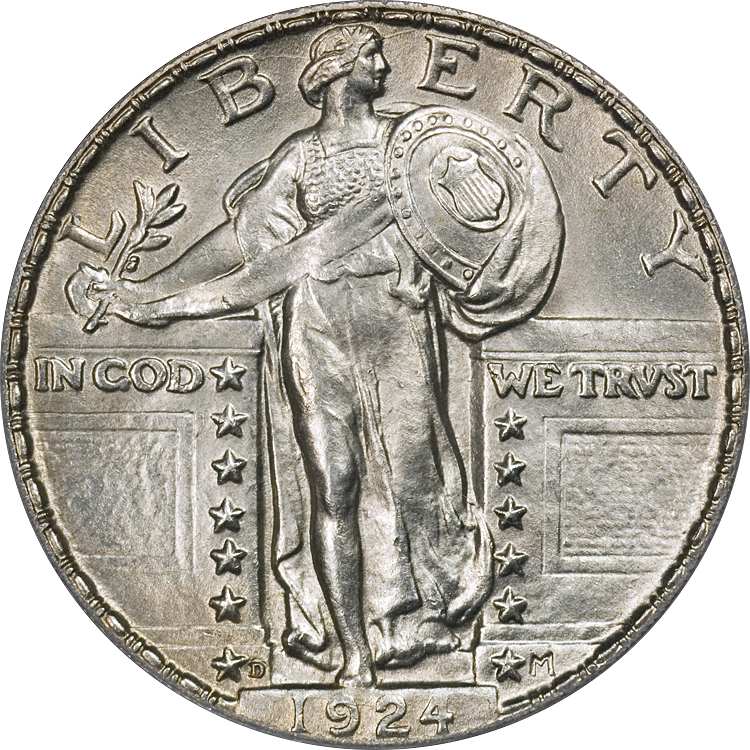 We might go on here to look at Hermon MacNeil’s excellent Standing Liberty quarter (1916-1930), with Miss Liberty, wearing the light drapery of a Greek goddess, bearing a great round shield on her left arm and shoulder as she faces Europe in the east, plunged in war. In her right hand she bears an olive branch; on the reverse is a glorious eagle, its wings raised in flight. That design places America in the context of a civilization more than 2,000 years old. Or we might look at another coin designed by Weinman, the Walking Liberty half dollar (1916-1947), whose tall Miss Liberty on the obverse, striding like a goddess, bears the American flag streaming in the breeze, along with branches of oak and laurel, while her right hand is extended forward in blessing, as a sower casting seed. The reverse features the eagle, perched on a mountain rock with a pine tree springing up from a fissure. The coin is both classical and American, rooted in a place, and grateful for its goodness and bounty.
We might go on here to look at Hermon MacNeil’s excellent Standing Liberty quarter (1916-1930), with Miss Liberty, wearing the light drapery of a Greek goddess, bearing a great round shield on her left arm and shoulder as she faces Europe in the east, plunged in war. In her right hand she bears an olive branch; on the reverse is a glorious eagle, its wings raised in flight. That design places America in the context of a civilization more than 2,000 years old. Or we might look at another coin designed by Weinman, the Walking Liberty half dollar (1916-1947), whose tall Miss Liberty on the obverse, striding like a goddess, bears the American flag streaming in the breeze, along with branches of oak and laurel, while her right hand is extended forward in blessing, as a sower casting seed. The reverse features the eagle, perched on a mountain rock with a pine tree springing up from a fissure. The coin is both classical and American, rooted in a place, and grateful for its goodness and bounty.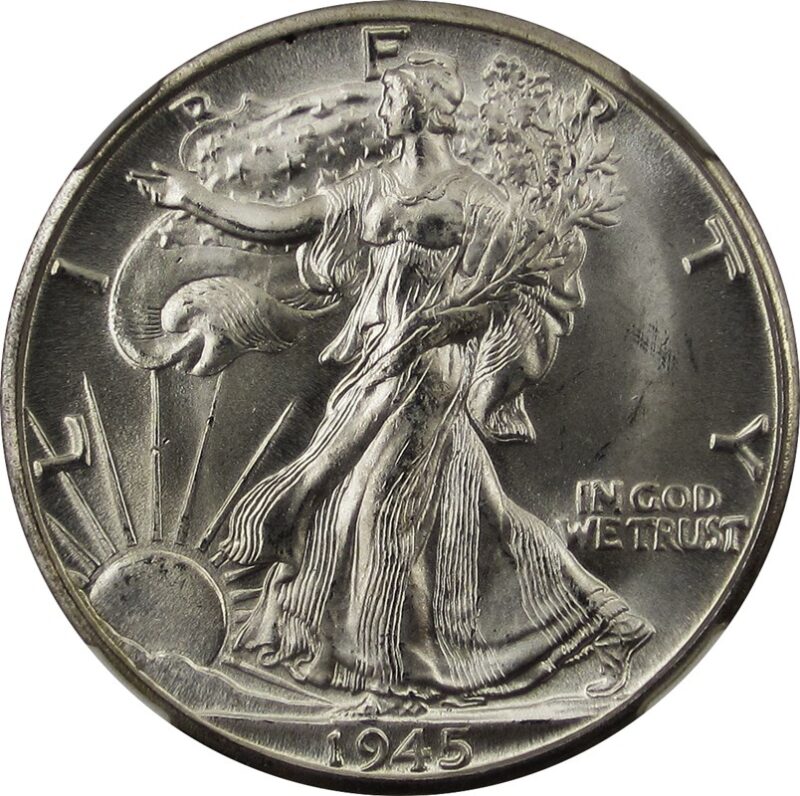
Those were splendid coins, and so too in my opinion is the Peace Dollar (1921-1935). But it’s the Indian Head or “Buffalo” nickel (1913-1938) that still can warm the remnant of the American heart. The grave and masculine Indian chief on the obverse was not a first for American coinage: Bela Pratt’s recessed or “incuse” Indian on the gold quarter eagle ($2.50) and half eagle ($5) saw the light in 1908.
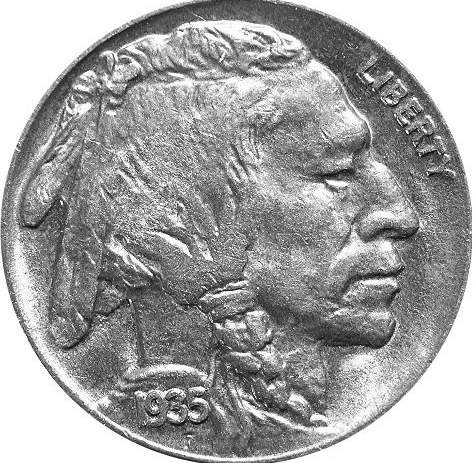 The association of the native Indians with liberty had long settled deep into the American consciousness. James Fenimore Cooper had written his Leatherstocking Tales long before Francis Parkman, in partial reaction against the figure of the noble savage and yet influenced by it too, wrote The Oregon Trail (1847-1849). The name of the great Indian chief Tecumseh, a worthy enemy of American expansion westward, an ally of the British against the United States in the War of 1812, and the most determined opponent of the Indiana governor, William Henry Harrison, who struck at Tippecanoe while the chief was away, was held in honor, not only by William Tecumseh Sherman’s father, but by Americans generally. Hence, for example, the U.S.S. Tecumseh (1863). Hence also the panel, The Death of Tecumseh, at the Battle of the Thames, gracing the frieze of the Capitol rotunda in Washington—painted, I am proud to say, by an Italian, Filippo Costaggini, whom the Irish coal miners of my hometown, Archbald, Pennsylvania, hired to come north to cover the walls and ceiling of their Catholic church with sacred art.
The association of the native Indians with liberty had long settled deep into the American consciousness. James Fenimore Cooper had written his Leatherstocking Tales long before Francis Parkman, in partial reaction against the figure of the noble savage and yet influenced by it too, wrote The Oregon Trail (1847-1849). The name of the great Indian chief Tecumseh, a worthy enemy of American expansion westward, an ally of the British against the United States in the War of 1812, and the most determined opponent of the Indiana governor, William Henry Harrison, who struck at Tippecanoe while the chief was away, was held in honor, not only by William Tecumseh Sherman’s father, but by Americans generally. Hence, for example, the U.S.S. Tecumseh (1863). Hence also the panel, The Death of Tecumseh, at the Battle of the Thames, gracing the frieze of the Capitol rotunda in Washington—painted, I am proud to say, by an Italian, Filippo Costaggini, whom the Irish coal miners of my hometown, Archbald, Pennsylvania, hired to come north to cover the walls and ceiling of their Catholic church with sacred art.
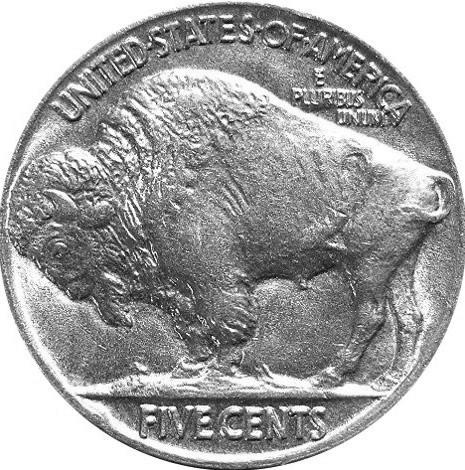 As for the buffalo (actually, a bison) on the reverse, the engraver James Fraser took for his model the Bronx Zoo’s notoriously ornery and majestic bull, Black Diamond. Fraser said he wanted the design to be unmistakably American, and sure enough, it appears that the great shaggy bison is standing on a slightly raised mound of an American prairie. The bison serves the same allegorical function as does the eagle, but is most fitting for the Indian chief on the other side of the coin, as we remember the times when the Indians roamed the plains, hunting the bison, whose herds of thousands made the earth tremble under their hooves. Fraser and his wife Laura also engraved the excellent Oregon Trail commemorative half dollar, featuring a standing Indian on the obverse, holding a bow in one hand and gesturing in what looks like an admonitory way with the other. On the reverse, a Conestoga wagon riding into the sunset.
As for the buffalo (actually, a bison) on the reverse, the engraver James Fraser took for his model the Bronx Zoo’s notoriously ornery and majestic bull, Black Diamond. Fraser said he wanted the design to be unmistakably American, and sure enough, it appears that the great shaggy bison is standing on a slightly raised mound of an American prairie. The bison serves the same allegorical function as does the eagle, but is most fitting for the Indian chief on the other side of the coin, as we remember the times when the Indians roamed the plains, hunting the bison, whose herds of thousands made the earth tremble under their hooves. Fraser and his wife Laura also engraved the excellent Oregon Trail commemorative half dollar, featuring a standing Indian on the obverse, holding a bow in one hand and gesturing in what looks like an admonitory way with the other. On the reverse, a Conestoga wagon riding into the sunset.
The Buffalo nickel is American, but in a way that gestures toward universality. The Indian is not bound to a particular personage. The bison in some other culture may have been the aurochs of ancient Europe, the yak of Tibet, the reindeer of Lapland, the elephant of India. The man who honors his place because it is his understands why another man far away does the same.
To go from Miss Liberty to Susan B. Anthony is to go from propaganda as expressing an already-existing unity—this is what we are at our best—to propaganda as a sales pitch or an ideological harassment—this is what you’d better believe, pal, or there’s the door. Robert Weinman, the son of Adolph and a great artist in his own right, said that the legislation mandating the Anthony dollar bespoke a “billboard or campaign button approach to a national coin.” Since then, we have shown we like those billboards. With few exceptions, the recent Statehood Quarters series was composed of tourist signs, such as what you will find when you cross a border: “Maine: The Way Life Should Be.” To go from the Buffalo nickel to the Sacagawea dollar is a similar descent. Glenna Goodacre’s young squaw carrying the papoose on her back is comely and far more appealing than was Frank Gasparro’s harridan. Sacagawea was not the main guide for Lewis and Clark. Her presence, said Clark, assisted them mainly by showing to Indian tribes that the expedition was peaceful, because otherwise a woman would not have been in the company at all. She was by all accounts a woman of grace and courage. I do not detract from her character, or from the expedition she assisted. But what does she represent? Why, other than for her sex and her ethnicity, was Sacagawea chosen?
Like the Anthony dollar, the Sacagawea did not catch on. It is now minted only for collections. Each year since 2009, the reverse has featured a tribute to the Indians. This is all rather patronizing, as I see it, because often the persons or the events engraved are known only to historical specialists. Such is Susan Gamble’s design for 2013, to commemorate a 1778 treaty with the Lenape Indians: it features three animals sacred to the Lenape: a turkey, a wolf, and a turtle. The wolf is howling, and the turkey in the foreground appears to be mounting the turtle.
Such also is Emily Damstra’s design for 2019, to commemorate two American Indians in the space program. One, Mary Ross, writes a physicochemical formula that she helped to discover, and the other—presumably it is the other, John Herrington—is a suited astronaut with a bubble helmet, grasping hold, from behind, of the circular band that contains the coin’s legend, and looking like an alien falling out of the sky. What does it mean? That Chickasaws are smart, too? Did we need to be told that? Again, it is not really a national coin so much as a metallic bumper sticker.
Of course, I realize that to complain is like shouting at the seashore when the ship has already sunk. Several years ago, I visited Arlington National Cemetery and the tomb of the Unknown Soldier. It was a moving experience of what used to be national fellow-feeling and national honor. As I was leaving, my experience was altered as I came across the Women’s Memorial—a campaign button in three dimensions, a monster in bad taste, with a neoclassical exterior and a political museum for an interior.
Compare the dignified treatment of Black Jack Pershing, buried beneath a simple gravestone, no bigger than any of the thousands nearby. It is eloquent in its silence; the Women’s Memorial says a great lot of nothing in its garrulity. But what should I have expected? Had the people who commissioned and designed the Women’s Memorial really been thinking about war, the ultimate sacrifice that over a million American men have made, and the patriotic ties that bind generations together, they would never have plopped down their circus tent on that hallowed ground.
I struggle to envision a redesigned coin that expresses American unity, when there is no longer unity to express. Hey, Miss Liberty! It was pretty good, while it lasted.
